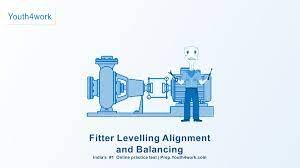
Introduction In the realm of engineering and industrial production, precision is paramount. Whether it’s assembling machinery, erecting structures, or aligning complex systems, the role of an Assistant Fitter is indispensable. Among their core responsibilities are levelling, alignment, and balancing (LAB), processes that ensure optimal functionality, safety, and longevity of equipment. This article delves into the intricacies of these tasks and highlights the crucial role Assistant Fitters play in achieving precision engineering.
Understanding Levelling, Alignment, and Balancing Levelling, alignment, and balancing are three distinct yet interconnected processes in engineering:
- Levelling involves adjusting components to ensure they are horizontally or vertically aligned according to specified standards. It prevents tilting or uneven distribution of loads, which can compromise stability and performance.
- Alignment focuses on positioning components relative to each other to achieve optimal operation. This includes angular alignment to ensure straightness, parallelism, or perpendicularity between parts.
- Balancing addresses the distribution of mass within rotating parts to minimize vibrations and reduce wear on bearings and other components. It is critical for smooth operation, energy efficiency, and avoiding catastrophic failures.
Assistant Fitter’s Role Assistant Fitters are skilled technicians who work alongside senior engineers and tradespeople to carry out LAB tasks. Their responsibilities encompass:
- Precision Measurement: Assistant Fitters utilize various measuring instruments such as spirit levels, dial indicators, laser alignment tools, and vibration analyzers to assess and correct deviations from desired specifications.
- Adjustment and Calibration: They make precise adjustments to machinery or components using shims, wedges, jacks, or hydraulic systems to achieve the required levelling, alignment, and balance.
- Troubleshooting: Assistant Fitters diagnose and troubleshoot alignment and balance issues, identifying root causes such as structural deformities, misalignments, or manufacturing defects.
- Documentation: They maintain detailed records of measurements, adjustments, and test results to ensure compliance with quality standards and facilitate future maintenance and repairs.
Challenges and Solutions Performing LAB tasks effectively requires overcoming various challenges:
- Complex Machinery: Modern industrial equipment often comprises intricate assemblies with multiple moving parts, presenting challenges in achieving precise alignment and balance.
Solution: Assistant Fitters undergo rigorous training to understand the principles of mechanics and develop proficiency in using advanced measurement and alignment techniques.
- Environmental Factors: Environmental conditions such as temperature variations, humidity, and vibration from nearby machinery can affect levelling, alignment, and balance.
Solution: Assistant Fitters employ compensatory techniques and adaptive strategies to mitigate the impact of environmental factors on precision engineering tasks. They may use temperature-resistant materials, vibration isolation mounts, or dynamic balancing methods to achieve optimal results.
- Time Constraints: In fast-paced production environments, there is often pressure to minimize downtime and expedite the LAB process without compromising quality.
Solution: Assistant Fitters prioritize efficiency without sacrificing accuracy by employing streamlined workflows, leveraging technology for rapid measurements and adjustments, and collaborating closely with other team members to coordinate tasks effectively.
Importance in Industry The importance of Assistant Fitters in levelling, alignment, and balancing cannot be overstated:
- Safety: Proper levelling, alignment, and balancing are essential for ensuring the safety of personnel and preventing accidents caused by equipment malfunction or structural instability.
- Performance: Well-aligned and balanced machinery operates more efficiently, delivering higher productivity, lower energy consumption, and reduced maintenance requirements.
- Reliability: Precise LAB enhances the reliability and longevity of equipment, reducing the risk of premature failures and costly downtime.
- Quality Assurance: LAB processes are integral to quality assurance in manufacturing, construction, and maintenance industries, ensuring that products meet stringent standards and customer expectations.

Future Trends and Innovations The field of levelling, alignment, and balancing is continuously evolving, driven by technological advancements and industry demands:
- Automation: The integration of robotics and automated systems enables faster and more accurate LAB tasks, reducing reliance on manual labor and enhancing consistency.
- Predictive Maintenance: Predictive analytics and condition monitoring technologies allow for proactive identification of alignment and balance issues before they escalate into critical failures, optimizing maintenance schedules and minimizing disruptions.
- Augmented Reality (AR): AR applications provide real-time guidance and visualization tools, empowering Assistant Fitters to perform LAB tasks with greater precision and efficiency, especially in complex or hazardous environments.
Conclusion Assistant Fitters play a pivotal role in achieving precision engineering through levelling, alignment, and balancing. Their expertise ensures the safety, performance, and reliability of industrial equipment across diverse sectors. As technology advances and demands for efficiency and quality continue to grow, the role of Assistant Fitters will remain indispensable in shaping the future of engineering excellence.
Through their mastery of LAB techniques, Assistant Fitters contribute to the foundation of a safer, more efficient, and technologically advanced industrial landscape.
